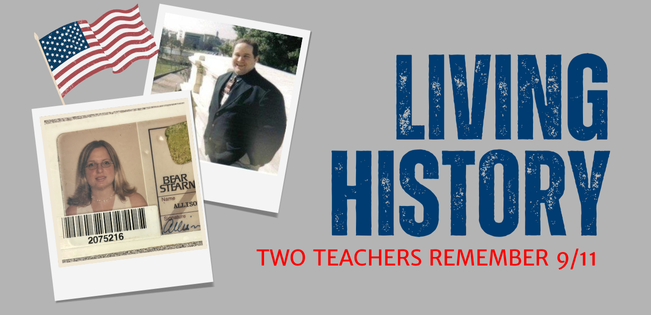On September 11, 2001, two of White Hall High School’s teachers were in very different places, but both found themselves at the center of one of the most devastating attacks in U.S. history. Today, Allison Young and Steven Lewis share their memories with students each year, keeping alive the lessons of a day that forever changed America.
A Test Interrupted in New York
Mrs. Young was 22 years old, just three months out of college and taking an important financial exam on the 30th floor of a Manhattan building, when the first plane hit the North Tower. “The instructor told us to keep going,” she said. But when the second tower was struck, blowing out a nearby window, she knew it was deliberate. “My father always said once, maybe an accident, but never twice. This was deliberate.” She and others raced down the stairwell and into chaos. “It was Armageddon,” she remembered. “Masses of people were running and screaming. Unfortunately, I witnessed people jumping out of the burning buildings because they were above where the planes hit. Office furniture and financial records were flying through the sky.”
As she made her way toward the Brooklyn Bridge, she saw moments of humanity amid the terror. “We weren’t rushing to the office but rushing to save our lives. A lady that sprinted with me went into labor. I helped her get into a bodega and find a first responder. Cab drivers were squeezing as many passengers as possible to either get over the bridge or to the nearest hospital.” Covered in debris and ash, Young eventually crossed the bridge as one of the towers collapsed behind her. She reunited with her mother, and together they walked 14 miles back to Bensonhurst, Brooklyn, to pick up her younger sister from school. Later that day, she discovered her feet were embedded with more than 100 shards of glass and metal. Her father, a police officer, worked nearly 900 hours of overtime in the months that followed.
A Morning on Capitol Hill
That same morning, Mr. Lewis was beginning his day in Washington, D.C., working for Senator Blanche Lincoln. Like millions of others, he watched as the second plane struck the World Trade Center, and soon after the U.S. Capitol went into lockdown.“ Everyone heard that it was a car bomb at the State Department,” he recalled. “We did not learn until hours later that it was actually a plane hitting the Pentagon.” Then came word that another hijacked plane was on its way toward the Capitol. “There was a mandatory evacuation. The plane they were referring to was United Flight 93 that crashed in Shanksville, Pennsylvania. Anyone that was working in the White House and the U.S. Capitol will forever be in debt to the passengers of Flight 93 for their sacrifice.”
When Lewis finally left Capitol Hill eight hours later, the short drive home turned into a grueling journey. “It took me six hours to drive what normally took 30 to 45 minutes."The days that followed showed a city transformed. “On my drive to work you saw military howitzers and anti-aircraft guns on the Capitol lawn and the Mall. In the air you heard fighter jets flying air cover over the city. That week and several weeks after 9/11 we were evacuated several times due to bomb threats.”
Reflecting back, Lewis said, “My colleagues and I owe our lives to the heroic actions of the passengers of United Flight 93 who stood up and said no more. This day is a day that will always be with me. I will never forget where I was or what I was doing on that day or the days and weeks afterwards.”
Nearly 25 years later, both teachers say those memories remain vivid. By sharing their stories, they help students understand that September 11 is not just something in history books. It is a lived experience, carried forward by those who were there.

